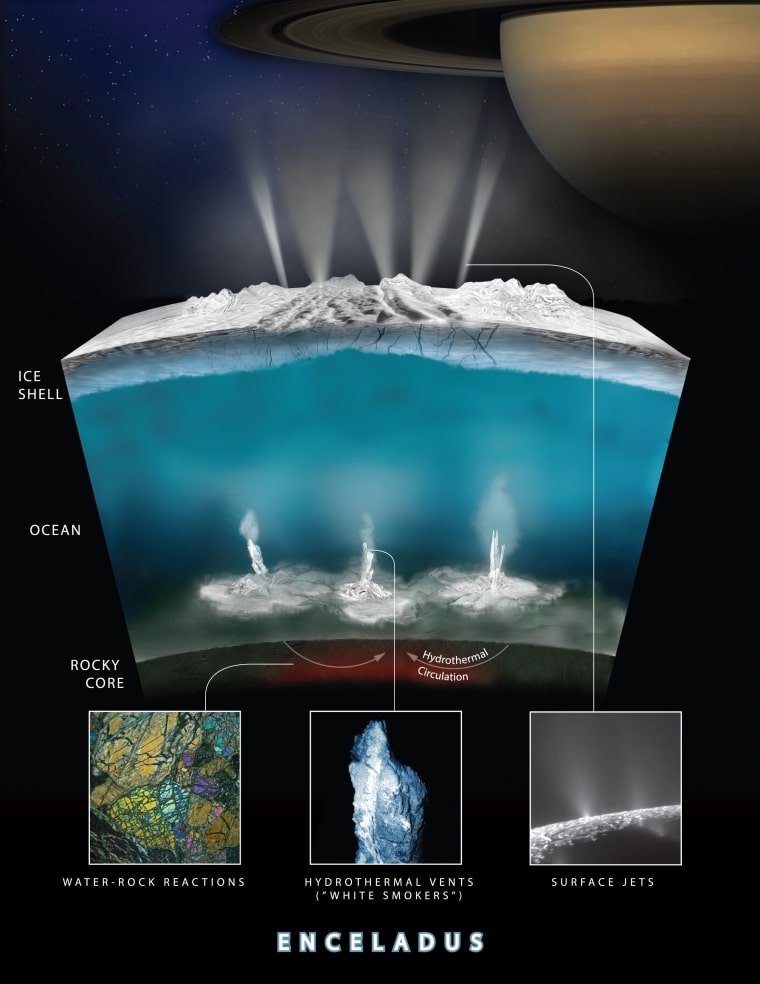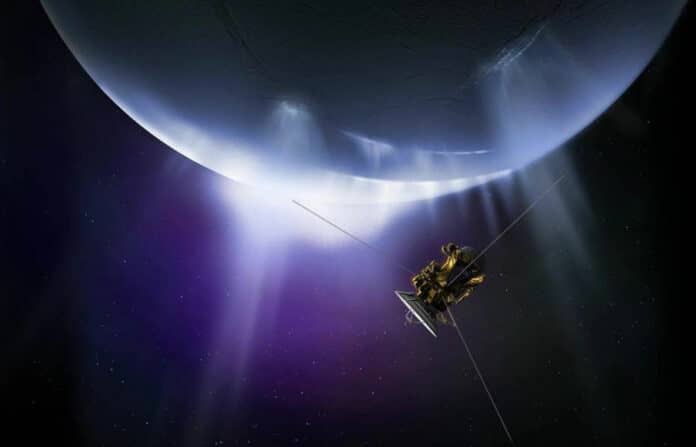Saturn’s moon Enceladus is a top candidate in our solar system’s search for extraterrestrial life. However, it remains a mystery whether microbial alien life might inhabit Enceladus.
Enceladus appeared to NASA’s Voyager 1 spacecraft as a small, unremarkable “snowball” in the sky when it was first observed in 1980. Later, from 2005 to 2017, NASA’s Cassini probe flew through the Saturnian System and performed unprecedented in-depth research on Saturn’s intricate rings and moons. The discovery by Cassini that Enceladus’ thick coating of ice conceals a large, warm saltwater ocean emitting methane, a gas that generally comes from microbial life on Earth, astounded scientists.
A new study by University of Arizona researchers suggests that the mystery of whether microbial alien life might inhabit Enceladus could be solved by an orbiting space probe. Researchers outlined how a fictitious space mission could deliver conclusive solutions.
A group of researchers from the Universities of Arizona and Paris’ Université Paris Sciences et Lettres last year concluded that there is a good chance that Enceladus has life and that this life may be the cause of the moon’s methane emissions.
Régis Ferrière, senior author of the new paper and associate professor in the UArizona Department of Ecology and Evolutionary Biology, said, “To know if that is the case, we must go back to Enceladus and look.”
According to the most recent analysis, even if the overall mass of possible living bacteria in the ocean of Enceladus would be minimal, a visit from an orbiting spacecraft would be all that is required to determine for definite whether Earthlike microbes are present in Enceladus’ water below its shell.

Ferrière said, “Clearly, sending a robot crawling through ice cracks and deep-diving down to the seafloor would not be easy. More realistic missions have been designed using upgraded instruments to sample the plumes like Cassini did, or even land on the moon’s surface.”
“By simulating the data that a more prepared and advanced orbiting spacecraft would gather from just the plumes alone, our team has now shown that this approach would be enough to confidently determine whether or not there is life within Enceladus’ ocean without actually having to probe the depths of the moon. This is a thrilling perspective.”
Enceladus, roughly 800 million miles from Earth, orbits Saturn every 33 hours. The moon is the only object in the solar system that reflects light like the moon does, even though it isn’t even as broad as the state of Arizona. The moon’s surface makes it stand out in the sky like a frozen pond in the sunlight. At least 100 enormous water plumes shoot out of the frozen surface of the moon’s south pole, resembling lava from a raging volcano.
One of Saturn’s famous rings is thought to be a result of water vapor and ice particles spewed by these geyser-like features, according to scientists. The Cassini mission took a sample of this ejected combination, which contains gases and other granules deep within Enceladus’ ocean.
The excess methane Cassini found in the plumes brings to mind hydrothermal vents, unique ecosystems found in the dark interiors of Earth’s oceans. Here, heated magma beneath the seafloor heats the ocean water in porous bedrock at the boundaries of two nearby tectonic plates, creating “white smokers,” vents that spout searing hot, mineral-rich saltwater. Because they cannot access sunlight, organisms must survive using the energy contained in the chemical substances that white smokers release into the environment.
Ferrière said, “On our planet, hydrothermal vents teem with life, big and small, despite the darkness and insane pressure. The simplest living creatures are microbes called methanogens that power themselves even in the absence of sunlight.”
“Methanogens convert dihydrogen and carbon dioxide to gain energy, releasing methane as a byproduct. Ferrière’s research group modeled its calculations based on the hypothesis that Enceladus has methanogens that inhabit oceanic hydrothermal vents resembling the ones found on Earth. In this way, the researchers calculated what the total mass of methanogens on Enceladus would be, as well as the likelihood that their cells and other organic molecules could be ejected through the plumes.”
Paper’s first author, Antonin Affholder, a postdoctoral research associate at UArizona who was at Paris Sciences & Lettres when doing this research, said, “We were surprised to find that the hypothetical abundance of cells would only amount to the biomass of one single whale in Enceladus’ global ocean. Enceladus’ biosphere may be very sparse. And yet our models indicate that it would be productive enough to feed the plumes with just enough organic molecules or cells to be picked up by instruments onboard a future spacecraft.”
“Our research shows that if a biosphere is present in Enceladus’ ocean, signs of its existence could be picked up in plume material without the need to land or drill, but such a mission would require an orbiter to fly through the plume multiple times to collect lots of oceanic material.”
“The possibility that actual cells could be found might be slim because they would have to survive the outgassing process carrying them through the plumes from the deep ocean to the vacuum of space – quite a journey for a tiny cell.”
Instead, the authors suggest that detected organic molecules, such as particular amino acids, would serve as indirect evidence for or against an environment abounding with life.
“Considering that according to the calculations, any life present on Enceladus would be extremely sparse, there still is a good chance that we’ll never find enough organic molecules in the plumes to conclude that it is there unambiguously,” Ferrière said. “So, rather than focusing on the question of how much is enough to prove that life is there, we asked, ‘What is the maximum amount of organic material that could be present in the absence of life?'”
Authors said, “If all measurements were to come back above a certain threshold, it could signal that life is a serious possibility.”
“The definitive evidence of living cells caught on an alien world may remain elusive for generations. Until then, the fact that we can’t rule out life’s existence on Enceladus is probably the best we can do.”
Journal Reference:
- Antonin Affholder et al. Putative Methanogenic Biosphere in Enceladus’s Deep Ocean: Biomass, Productivity, and Implications for Detection. The Planetary Science Journal. DOI 10.3847/PSJ/aca275
